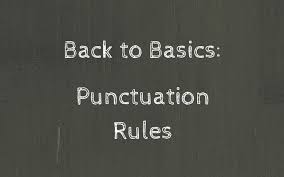The most common punctuation marks in English are capital letters and full stops, question marks, commas, colons and semi-colons, exclamation marks and quotation marks.

In speaking, we use pauses and the pitch of the voice to make what we say clear. Punctuation plays a similar role in writing, making it easier to read.
Punctuation consists of both rules and conventions. There are rules of punctuation that have to be followed, but there are also punctuation conventions that give writers greater choice.
* A period is used :
-at the end of declarative sentence & mild imperatives.
-after initials & abbreviation
-only once for a sentence ending with an abbreviation
* A question mark is used :
-at the end of an interrogative sentence
* Exclamation mark is used :
– after a word, phrase or sentence showing strong feeling.
* A comma is used –
-to separate two or more adjectives of equal rank.
-to set off a direct quotation.
-to separate three or more words, clauses, or phrases in a series.
-to separate two independent clauses in a compound sentence.
-to set off a word, phrase or dependent clause at the beginning of a sentence.
* A semicolon is used :
– to separate independent clauses very close in meaning but not separated by, and, but or for, nor or yet.
– to separate items in a series when the series already contains commas
* A colon is used :
– before a list of items or details
– before a statement that summarises the original statement.
– before a long, formal quotation or statement.
* Paraphrases are used :
– to set off words, phrases, clauses or sentences which are independent of the main part of the sentence.
* Quotation marks are used:
– to set off words, phrases or sentences referred to in the sentences.
– to set off slang and foreign words or phrases
Punctuation rules
The most common punctuation marks in English are: capital letters and full stops, question marks, commas, colons and semi-colons, exclamation marks and quotation marks.
In speaking, we use pauses and the pitch of the voice to make what we say clear. Punctuation plays a similar role in writing, making it easier to read.
Punctuation consists of both rules and conventions. There are rules of punctuation that have to be followed, but there are also punctuation conventions that give writers greater choice.
* A period is used :
– at the end of declarative sentence & mild imperatives.
– after initials & abbreviation
– only once for a sentence ending with an abbreviation
* A question mark is used :
– at the end of an interrogative sentence
* Exclamation mark is used :
– after a word, phrase or sentence showing strong feeling.
* A comma is used –
– to separate two or more adjectives of equal rank.
– to set off a direct quotation.
– to separate three or more words, clauses, or phrases in a series.
– to separate two independent clauses in a compound sentence.
– to set off a word, phrase or dependent clause at the beginning of a sentence.
* A semicolon is used :
– to separate independent clauses very close in meaning but not separated by, and, but or for, nor or yet.
– to separate items in a series when the series already contains commas
* A colon is used :
– before a list of items or details
– before a statement that summarises the original statement.
– before a long, formal quotation or statement.
* Paraphrases are used :
– to set off words, phrases, clauses or sentences which are independent of the main part of the sentence.
* Quotation marks are used:
– to set off words, phrases or sentences referred to in the sentences.
– to set off slang and foreign words or phrases